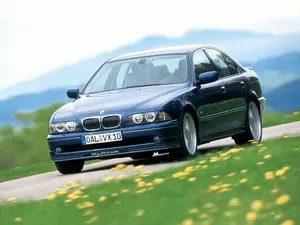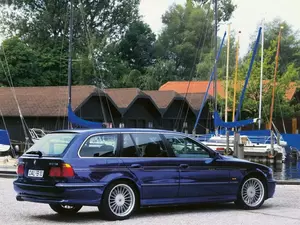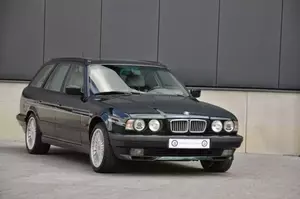
| Vehicle | Curb weight | Difference from world's smallest | Weight to power ratio | 0—60 mph acceleration ratio | Consumption ratio |
|---|---|---|---|---|---|
| 3.3 i 24V |
1540 kg / 3396 lbs |
1115 kg (2459 lbs) heavier | 6 kg to 1 hp | 257 kg/s (567 lbs/s) |
152 kg/L (335 lbs/L) |
| 4.6 i V8 32V Switchtronic |
1540 kg / 3396 lbs |
1115 kg (2459 lbs) heavier | 4 kg to 1 hp | 257 kg/s (567 lbs/s) |
116 kg/L (256 lbs/L) |
| 4.8 i V8 32V |
1690 kg / 3726 lbs |
1265 kg (2789 lbs) heavier | 5 kg to 1 hp | 331 kg/s (730 lbs/s) | - |
| Vehicle | 3.3 i 24V |
|---|---|
| Curb weight |
1540 kg / 3396 lbs |
| Difference from world's smallest | 1115 kg (1115 lbs) heavier |
| Weight to power ratio | 6 kg to 1 hp |
| 0—60 mph acceleration ratio | 257 kg/s (567 lbs/s) |
| Consumption ratio |
152 kg/L (335 lbs/L) |
| Vehicle | 4.6 i V8 32V Switchtronic |
| Curb weight |
1540 kg / 3396 lbs |
| Difference from world's smallest | 1115 kg (1115 lbs) heavier |
| Weight to power ratio | 4 kg to 1 hp |
| 0—60 mph acceleration ratio | 257 kg/s (567 lbs/s) |
| Consumption ratio |
116 kg/L (256 lbs/L) |
| Vehicle | 4.8 i V8 32V |
| Curb weight |
1690 kg / 3726 lbs |
| Difference from world's smallest | 1265 kg (1265 lbs) heavier |
| Weight to power ratio | 5 kg to 1 hp |
| 0—60 mph acceleration ratio | 331 kg/s (730 lbs/s) |
| Consumption ratio | - |

| Vehicle | Curb weight | Difference from world's smallest | Weight to power ratio | 0—60 mph acceleration ratio | Consumption ratio |
|---|---|---|---|---|---|
| 3.3 i 24V |
1640 kg / 3616 lbs |
1215 kg (2679 lbs) heavier | 6 kg to 1 hp | 256 kg/s (564 lbs/s) |
161 kg/L (355 lbs/L) |
| 4.6 i V8 32V |
1800 kg / 3969 lbs |
1375 kg (3032 lbs) heavier | 5 kg to 1 hp | 333 kg/s (734 lbs/s) |
135 kg/L (298 lbs/L) |
| 4.8 i V8 32V |
1800 kg / 3969 lbs |
1375 kg (3032 lbs) heavier | 5 kg to 1 hp | 340 kg/s (750 lbs/s) | - |
| Vehicle | 3.3 i 24V |
|---|---|
| Curb weight |
1640 kg / 3616 lbs |
| Difference from world's smallest | 1215 kg (1215 lbs) heavier |
| Weight to power ratio | 6 kg to 1 hp |
| 0—60 mph acceleration ratio | 256 kg/s (564 lbs/s) |
| Consumption ratio |
161 kg/L (355 lbs/L) |
| Vehicle | 4.6 i V8 32V |
| Curb weight |
1800 kg / 3969 lbs |
| Difference from world's smallest | 1375 kg (1375 lbs) heavier |
| Weight to power ratio | 5 kg to 1 hp |
| 0—60 mph acceleration ratio | 333 kg/s (734 lbs/s) |
| Consumption ratio |
135 kg/L (298 lbs/L) |
| Vehicle | 4.8 i V8 32V |
| Curb weight |
1800 kg / 3969 lbs |
| Difference from world's smallest | 1375 kg (1375 lbs) heavier |
| Weight to power ratio | 5 kg to 1 hp |
| 0—60 mph acceleration ratio | 340 kg/s (750 lbs/s) |
| Consumption ratio | - |

| Vehicle | Curb weight | Difference from world's smallest | Weight to power ratio | 0—60 mph acceleration ratio | Consumption ratio |
|---|---|---|---|---|---|
| 4.6 i V8 32V |
1680 kg / 3704 lbs |
1255 kg (2767 lbs) heavier | 5 kg to 1 hp | 280 kg/s (617 lbs/s) |
145 kg/L (320 lbs/L) |
| 4.0 i V8 32V |
1725 kg / 3804 lbs |
1300 kg (2867 lbs) heavier | 5 kg to 1 hp | 270 kg/s (595 lbs/s) |
146 kg/L (322 lbs/L) |
| Vehicle | 4.6 i V8 32V |
|---|---|
| Curb weight |
1680 kg / 3704 lbs |
| Difference from world's smallest | 1255 kg (1255 lbs) heavier |
| Weight to power ratio | 5 kg to 1 hp |
| 0—60 mph acceleration ratio | 280 kg/s (617 lbs/s) |
| Consumption ratio |
145 kg/L (320 lbs/L) |
| Vehicle | 4.0 i V8 32V |
| Curb weight |
1725 kg / 3804 lbs |
| Difference from world's smallest | 1300 kg (1300 lbs) heavier |
| Weight to power ratio | 5 kg to 1 hp |
| 0—60 mph acceleration ratio | 270 kg/s (595 lbs/s) |
| Consumption ratio |
146 kg/L (322 lbs/L) |